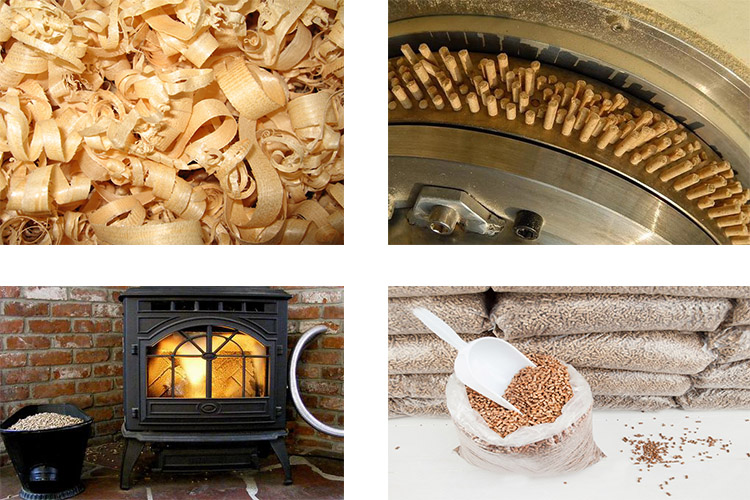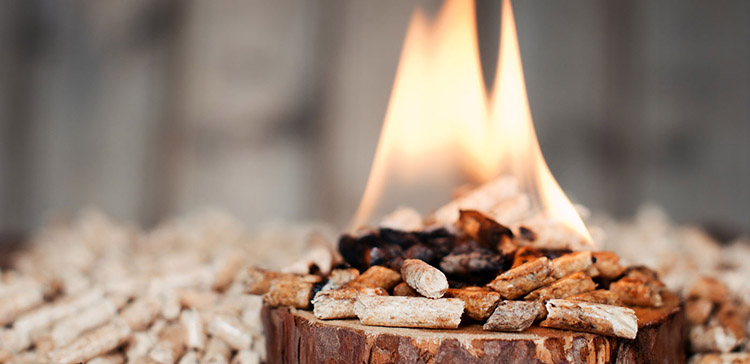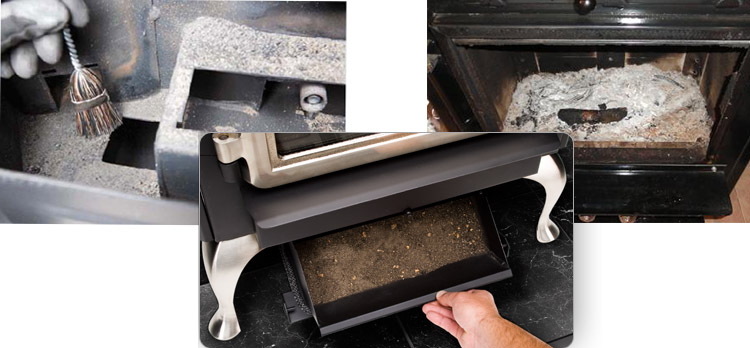
The Carbon, Hydrogen, Oxygen And Volatiles Content of Biomass Pellets
Biomass, is organic matter which comes from living and recently living organisms. Therefore, the carbon, hydrogen and oxygen and other volatiles content are the main components of the biomass raw materials for pellet production. Although these elements does not influence the applicability of the biomass materials for pelletisation, it does have an influence on the gross calorific value and the net calorific value. The volatiles effect the combustion behaviour of the biomass pellets, as carbon and Hydrogen are the main elements which is responsible for the energy content during the combustion. For the record, the woody biomass contains higher carbon and hydrogen and volatiles concentrations than the herbaceous biomass. The volatiles in woody biomass is about 70 wt.% – 86 wt.%(d.b.), and the volatiles in herbaceous biomass is about 70 wt.% – 84 wt.%(d.b.). This high volatile content causes the fast vaporisation of the biomass materials which has a strong impact on the thermal degradation of the biomass pellets.
The concentrations of C, H, O and volatiles in biomass pellets
| Fuel type | Carbon
wt.%(d.b.) |
Hydrogen
wt.%(d.b.) |
Oxygen
wt.%(d.b.) |
Volatiles
wt.%(d.b.) |
| Wood chips
(spruce, beech, poplar, willow) |
47.1-51.6 | 6.1-6.3 | 38.0-45.2 | 76.0-86.0 |
| Bark
(coniferous trees) |
48.8-52.5 | 4.6-6.1 | 38.7-42.4 | 69.6-77.2 |
| Straw
(rye, wheat, triticale) |
43.2-48.1 | 5.0-6.0 | 36.0-48.2 | 70.0-81.0 |
| Miscanthus
|
46.7-50.7 | 4.4-6.2 | 41.7-43.5 | 77.6-84.0 |
The Nitrogen, Sulphur And Chlorine of Biomass Pellets
The content of nitrogen, sulphur and chlorine of biomass pellets are limited by the European standard, EN 14961-2. The content requirements of the European standard are based on wood which is the most popular raw materials to produce biomass pellet. It is much lower than the concentrations of nitrogen, sulphur and chlorine in herbaceous biomass. The concentrations of nitrogen, sulphur and chlorine does not effect the production of biomass pellet, but it does have a strong influence on the choice of the raw materials for biomass pellets production of the biomass pellet plants. It is aimed to avoid the materials which is contaminated and not suitable for biomass pellet production.
During the combustion period of biomass pellets, the nitrogen in the pellets is almost completely released to the gas phase, it is also the same with the sulphur and chlorine in the biomass pellets. Also the limitation of these elements is mainly due to the environment concern. The high content of nitrogen, sulphur and chlorine will augment the emissions of NOx, Sox and HCI.
The concentrations of N, S, CI in biomass pellets
| Fuel type | Nitrogen
wt.%(d.b.) |
Sulphur
wt.%(d.b.) |
Chlorine
wt.%(d.b.) |
| Wood
(spruce) |
900-1,700 | 70-1,000 | 50-60 |
| Bark
(spruce) |
1,000-5,000 | 100-2,000 | 100-370 |
| Straw
(winter wheat) |
3,000-5,000 | 500-1,100 | 1,000-7,000 |
| Whole crops
(triticale) |
6,000-14,000 | 1,000-1,200 | 1,000-3,000 |

Gross Calorific Value, Net Calorific Value And Energy Density of Biomass Pellets
Gross calorific value, aka the higher heating value, means after the complete combustion, and the products of the combustion has been cooled down, the total amount of heat that produced by the fuel. The gross calorific value of a raw materials should be as high as the energy density of the wood pellets. The energy density of wood pellets is totally depend on the chemical composition of the used raw materials. Net calorific value, also known as the lower heating value, means the heating value when the gross calorific value subtracts the heat of vaporization of the water vapor. By no means, the net calorific value mainly depends on the gross calorific value, it is also influenced by the moisture content of the biomass pellets and the concentration of hydrogen in the biomass pellets.
The energy density of biomass pellets is the volume of energy which is contained in a unit weight of the densified biomass pellet fuel. The calculation of biomass pellet energy density is determined by the net calorific value and the bulk density of wood pellets. The equation to calculate the energy density of biomass pellets is placed as follow:

Moisture Content of Biomass Pellets
The moisture content of biomass pellets is the volume of water which is contained in the biomass pellet fuel. The allowed moisture content of biomass materials for pelletization is mainly determined by the pelletizing technology, but also influenced by the used raw materials. The proper moisture content of a raw materials for biomass pellets production is about 8% – 12%, but the moisture content is never a knock out element for the choice of biomass raw materials. If the moisture content of the raw materials is too high, to install a dryer in the biomass pellet plant is a recommended choice. As the moisture content of biomass pellets production is defined as no more than 10% according to the European standard EN 14961-2, the drying process is now a necessary procedure in the standard biomass pellet plants.
Ash Content of Biomass Pellets
The ash content of the raw materials of wood pellets does not effect the pelletizing process, also, if the ash content of the raw materials is too low, the weariness of the pellet mill rollers and dies will increase. However, the European standard EN 14961-2 has a special rules for the A1 wood pellets, which is the maximum ash content of raw materials to produce A1 wood pellets is 0.7%.
Although the ash content of the raw materials may not be a problem, the ash content of the biomass pellet is important factor which influenced the users experience, especially for the residential heating purpose. The less the ash content of biomass pellets remains, the longer emptying intervals for the ash box will be. Besides, the high ash contents may also increase the slag and deposit formation in the combustion chamber of the pellet stove, and if the slag is too much, it may cause the operative failures of the pellet stoves. The other reason to control the ash content of biomass pellets is that high ash content will cause the particulate matter emissions during the combustion period of the pellet stove, it is also against the users experience.
Ash contents of different types of biomass materials
| Biomass type | Ash content |
| Softwood | 0.4 – 0.8 |
| Hardwood | 1.0 – 1.3 |
| Bark | 2.0 – 5.0 |
| Straw | 4.9 – 6.0 |
Ash Forming Elements Relevant for Combustion
The ash melting point of biomass pellets which is determined by some elements in the pellets has a strong influence on the combustion behavior of the pellet fuel. A low ash melting point can cause the slag and deposit formation in the pellet stoves. The main elements that influenced the ash melting point are calcium, magnesium, silicon and potassium which you can find them in the woody materials. Calcium and magnesium will make the ash melting point higher, on the contrary, potassium and sodium make it lower.
The content of ash forming elements in biomass materials
| Biomass type | Ca
wt.%(d.b.) |
K
wt.%(d.b.) |
Mg
wt.%(d.b.) |
Na
wt.%(d.b.) |
P
wt.%(d.b.) |
Si
wt.%(d.b.) |
| Wood
(spruce) |
26-38 | 4.9-6.3 | 2.2-3.6 | 0.3-0.5 | 0.8-1.9 | 4.0-11.0 |
| Bark
(spruce) |
24-36 | 3.5-5.0 | 2.4-5.6 | 0.5-0.7 | 1.0-1.9 | 7.0-17.0 |
| Straw
(wheat, rye) |
4.5–8.0 | 10.0-16.0 | 1.1-2.7 | 0.2-1.0 | 0.2-6.7 | 16.0-30.0 |
| Whole crops
(wheat, triticale) |
3.0-7.0 | 11.0-18.0 | 1.2-2.6 | 0.2-0.5 | 4.5-6.8 | 16.0-26.0 |

Natural Binding Agents of Biomass Pellets
The natural binding agent is a natural material that can bound the materials together with their own shape, such as starch and fat. The proper utilization of binding agent is extremely important for the pelletizing process and the biomass pellet quality of biomass pellet plants. A high content of fats can ease the energy consumption of the pellet plant, which can help the pellet plant owners to reduce the operating costs of the biomass pellet plant. The starch in the biomass materials can improve the mechanical durability of the biomass pellets. Therefore, the utilization of biological additives are used for such purpose.
The Contaminations of Biomass Pellet Raw Materials
Mineral contamination
The mineral contaminants such as pebbles, soil must be kept in the biomass materials as low as possible. The mineral contaminants have a bad influence on the net calorific value of the biomass pellets, and may easily cause the wear problem of the rollers and dies of the pellet mills.
Heavy metals
The heavy metal means the metal which has a density that is greater than 4.5 g/cm³, such as gold, silver, copper, iron, lead, zinc, cadmium and so on. Heavy metals have a great influence on ash quality and the particulate emissions of the pellets combustion, also in consideration of the environment problem, the concentrations of heavy metals in biomass pellets and ash is limited by the European standard EN 14961-2. The herbaceous biomass normally remains lower heavy metals than the woody biomass, this is mainly because its shorter growth period compared to the woody biomass. The typical concentrations of heavy metals in different biomass materials are listed as follow:
| Element | Unit | Limit value | Wood
(spruce) |
Bark
(spruce) |
Straw
(wheat, rye) |
Whole crops
(wheat, triticale) |
| As | mg/kg | ≤ 1 | 0.0 – 1.5 | 0.2 – 5 | 1.6 | 0.6 |
| Cd | mg/kg | ≤ 0.5 | 0.06 – 0.4 | 0.2 – 0.9 | 0.03 – 0.22 | 0.04 – 0.1 |
| Cr | mg/kg | ≤ 10 | 1.6 – 17 | 1.6 – 14 | 1.1 – 4.1 | 0.4 – 2.5 |
| Cu | mg/kg | ≤ 10 | 0.3 – 4.1 | 1.5 – 8.0 | 1.1 – 4.2 | 2.6 – 3.9 |
| Pb | mg/kg | ≤ 10 | 0.3 – 2.7 | 0.9 – 4.4 | 0.1 – 3.0 | 0.2 – 0.7 |
| Hg | mg/kg | ≤ 0.1 | 0.01 – 0.17 | 0.01 – 0.17 | 0.01 | 0 – 0.02 |
| Ni | mg/kg | ≤ 10 | 1.7 – 11 | 1.6 – 13 | 0.7 – 2.1 | 0.7 – 1.5 |
| Zn | mg/kg | ≤ 100 | 7 – 90 | 90 – 200 | 11 – 57 | 10 – 25 |
Continue your reading with other pellet plant handbook post:
Pellet Plant Handbook : The History of Pellet Mill
Pellet Plant Handbook : ENplus Certification for Wood Pellet Plant
Pellet Plant Handbook : Wood Pellet Standards in Europe
Pellet Plant Handbook : The Physical Characteristics of Wood Pellet
Pellet Plant Handbook : The Interdependencies Between Biomass Pellet Parameters
